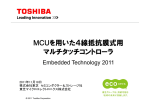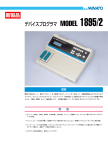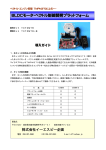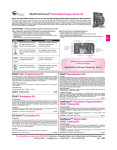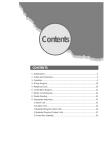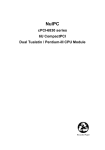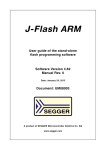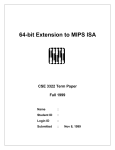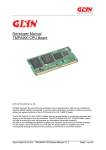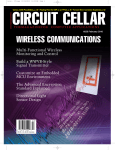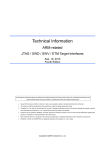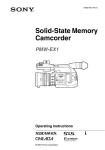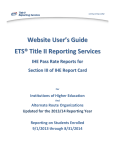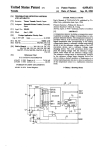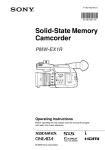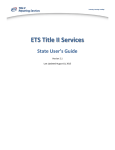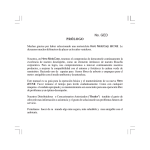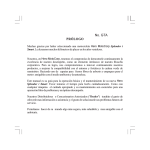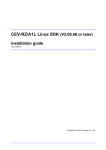Download Toshiba Microcomputers
Transcript
2010-8 PRODUCT GUIDE Microcomputers h t t p : / / w w w. s e m i c o n . t o s h i b a . c o . j p / e n g Toshiba Microcomputers Protecting the global environment is all-important, and more and more electronic appliances are being designed with this end in view. In these circumstances, sensing, power electronics and energy management technologies hold the key to addressing the needs of electronics manufacturers. When it comes to these technology areas, we recognize that it is necessary to improve accuracy and performance and, at the same time, reduce power consumption. Toshiba's product offerings now include mixed-signal controllers and those featuring a high-performance ARM CPU core. Additionally, Toshiba provides system solutions that combine these microcontrollers with a wide array of semiconductor devices such as power drivers. Microcomputer Lineup TX ARM Core-Based Microcontrollers TX 09 Mixed-Signal Controllers ARM926EJ-STM TX 03 MSC ARM CortexTM-M3 TLCS Family TX TX System RISC TX 49 TLCS-900 TX 39 MIPSIII* MIPSII* TLCS-870 TX 19 MIPSII* & MIPS16 *These are original cores developed independently by Toshiba based on each MIPS architecture. 8 bit 16 bit 32 bit 64 bit Contents Toshiba Microcomputers ..................................................................... 2 to 3 Toshiba’s ARM Core-Based Microcontrollers ............................................. 4 Toshiba’s ARM Core-Based Microcontroller Development Environment.... 5 Toshiba’s ARM Core-Based Microcontroller Part Number List ............ 6 to 7 Toshiba TX System RISC ........................................................................... 8 Toshiba TLCS-900 and TLCS-870 Family Lineup ...................................... 9 Microcontrollers with Inverter Motor Control Circuit (PMD) ............. 10 to 13 Applications: Home Appliances ....................................................... 14 to 15 Applications: Digital Consumer Electronics ..................................... 16 to 19 Applications: Automotive Safety Systems ................................................ 20 Applications: Car Audio Systems .................................................... 21 to 22 TranShare™ ............................................................................................. 23 Mixed-Signal Controllers ................................................................. 24 to 25 Development Systems .................................................................... 26 to 27 Third-Party Development Support Tools.......................................... 28 to 30 Reference Models and Microcontroller Starter Kits .................................. 31 Note: System block diagrams herein only show the typical application examples. NANO FLASH is a trademark of Toshiba Corporation. ARM, ARM Cortex, Thumb, ARM Cortex-M3, ARM926EJ-S and ARM Cortex-A9 MPCore are trademarks or registered trademarks of ARM Limited in the EU and other countries. 2 Toshiba’s ARM Core-Based Microcontrollers TX03 Series Product Lineup ROM size ■ Product Groups with a 3-V Supply 2 MB M360F20** M320 Group USB-Host Features USB host controller System solutions that combine an MCU and an audio DSP ● Application examples Car audio systems, consumer electronics, office equipment ● **:: Under development 1 MB + + Under planning M321F10** M363F10 M340FD++ M361F10 M322F10 ** M364F10** M362F10 M330 Group M341FD** M333FD M368FD** M330FD M367FD** M330FDW M361FD+ + M369FD** Power-saving modes CEC controller Features Dedicated controller compliant with HDMI 1.3a (CEC) Remote control signal preprocessor essential for digital consumer electronics ● Application examples Digital TVs, projectors, Blu-ray recorders, AV receivers, printers, home appliances, factory automation equipment, office equipment ● M362FD** 512 KB M340 Group High-resolution PPG Features High-accuracy analog control interface Small packages ideal for space-critical applications High-resolution PPG ideal for motor control ● Application examples DVCs, DSLR cameras, camera lens controllers ● M341FY++ M369FY** M396FY++ M360 Group M340FY++ M380FY** Multiple serial interfaces Features 2-MB FLASH ROM, the industry's largest on-chip memory Multiple serial interfaces Flexible power-saving modes ● Application examples Printers, AV receivers, digital electronics, PC peripherals, industrial equipment, networking equipment, office equipment ● 256 KB M333FY M370FY M330FY M368FY** M330FYW** M367FY** M390 Group 1.8-V operation Features Power-saving modes for 1.8-V operation High-speed on-chip oscillator Small package (6-mm square BGA) ● Application examples Power supply monitors, battery-operated devices, remote-controlled devices, game consoles, AV equipment ● M395FW M390FW** M374FW** M380FW** M373FW** M368FW** ■ Product Groups with a 5-V Supply 128 KB M370 Group M372FW** M382FW** M332FW M333FW M367FW** M330FW M380 Group ≤ 96 KB On-chip vector engine Features Toshiba-original vector engine (VE) Single 5-V supply operation with high market demands System solutions that combine an MCU with motor drivers ● Application examples Washing machines, air conditioners, refrigerators, heat pumps, inverter-motor-controlled equipment ● M382FS** Multiple-purpose timers for IGBT control Features Multiple-purpose timers for motor and IGBT control Single 5-V supply operation with high market demands System solutions that combine an MCU with various peripheral ICs ● Application examples Air conditioners, refrigerators, electric oven-grills, rice cookers, IH cooktops ● ROM less M320 ≤ 64 pins 100 pins 128 pins ≤ Pin Count 120 pins TX09 Series Product Lineup RAM size A911CR 56 KB A900 Group A910CR USB-Host Features USB host and device controllers LCD, CMOS camera interface and SD controllers Packaging: 289- and 177-pin BGAs Oscillation frequency detection (OFD), which warns of irregular clocking ● Application examples Electric ovens with an LCD screen, security devices, versatile remote controllers ● A901CM A900CM 32 KB A912CM 16 KB A910 Group A913CH Feature Richness 3 Designed for up to VGA-size color LCD screen control Features LCD data process accelerator USB device controller Various external memory controllers and high-speed interfaces ● Application examples Small to medium-size LCD control, digital photo frames, handheld gadgets ● Toshiba’s ARM Core-Based Microcontrollers Toshiba has been expanding its portfolio of application-specific standard products (ASSPs) that combine an ARM CortexTM-M3 core, which features high performance, high code density and low power consumption, with a Toshiba-original NANO FLASHTM, which features high-speed programming and low power consumption. In addition to the low-cost ARM CortexTM-M3-based ASSPs, Toshiba also offers ASSPs with the ARM926EJ-STM core that are ideal for applications with an LCD screen. With Toshiba’s wide range of ASSP offerings covering 8-bit to 32-bit, you can find the optimum solutions for your applications. Our product portfolio includes ASSPs that are specifically designed for digital TV, digital audio and motor applications; kitchen appliance and home appliances, as well as industrial, office and automotive applications. Features of the TX03 Series ARM CortexTM-M3 core ● Hardware CPU Industry’s highest code density ● High ® Thumb -2 ISA with 32-bit and 16-bit instructions Programmers can create software without being concerned about ARM and Thumb codes. Code ● ● ● ● ● Vector Engine MultiplePurpose Multiple ARM CortexTM-M3 Interrupt Serial Connectivity Allows embedding of industry’s highest-capacity memory. A microcontroller with a 2-MB NANO FLASHTM is currently under development. CEC AV Link TMPM330 Group Controller Mobile Features Unique to Toshiba’s ASSPs All ASSPs provides a PC trace capability. The ICE pins do not require a pull-up resistor. The ARM CortexTM-M3 operates from a single 5-V supply. (TMPM370 and TMPM380 Groups) TMPM360 Group Interfaces Hardware TX03 Series Response TMPM380 Group Timers HA Fast Instructions with long execution times can be suspended or canceled via interrupts. The hardware automatically pushes registers onto stack. High capacity and low power consumption ● TMPM370 Group Control ARM Core Ideal for Embedded Applications Density Ideal for real-time control Vector ARM CortexTM-M3 De facto standard The best-proven HW/SW development environment and support services Independent TMPM390 Group RTC MSC NANO FLASHTM High-Accuracy ADC and DAC Car Audio On-Chip High-Capacity TMPM340 Group USB Host TMPM320 Group Memory Controller Features of the TX09 Series ARM926EJ-STM ● High-Capacity De facto standard The best-proven HW/SW development environment and support services SD I/O Card Interface ARM926EJ-STM CPU SD Host Controller ARM Core Ideal for Multimedia Applications TMPA900 Group ARM926EJ-STM Up to 200 MHz ● On-chip 16-KB data and instruction caches High Performance Full-Speed USB Host USB Controller TX09 Series TMPA900 Group ARM core ideal for multimedia applications ● Support for USB High-Speed Supports USB 2.0 high-speed mode (480 Mbps). Full-color LCD controller ● ● Mode Full-Color 800 × 600 pixel resolution with 16- or 24-bit color depth LCD data process accelerator (Bi-cubic filter, alpha-blending, overlay rotation, 1x to 256x up-scaling, 1 to 1/16 down-scaling) OFD USB Device Detection Memory Controller LCD Controller LCD Oscillation Frequency Various LCDDA Controller Memory Interfaces Supports various memory interfaces ● SDRAM (3.3 V/1.8 V), DDR SDRAM (1.8 V) NAND FLASH (SLC/MLC), NOR FLASH Applications TX03 Series TX09 Series Camera applications DVC/DSLR FA Networking Automotive equipment ARM CortexTM-M3 TX03 Series Digital TVs Sensor applications Camera shake, drop and tilt Inverter home appliances Air conditioners White goods Consumer electronics AV and office equipment Health appliances 4 Personal digital assistants (PDAs) ARM926EJ-STM TX09 Series Home appliances with an LCD screen Toshiba’s ARM Core-Based Microcontroller Development Environment The ARM Core-based microcontrollers are supported by a wide selection of development tools and vendors, from which you can choose the ones that best meet your needs. TX03 Series Compiler Development System Debugger/Emulator KEIL KEIL(ARM) IAR IAR Real-Time OS Programming Tool TOSHIBA INFOMATION SYSTEMS YDC IAR eForce Computex Computex Sophia Systems MINATO HI-LO Flash Support Group In addition to the development tools shown above, starter kits are available from multiple vendors. For details, see "Reference Models and Microcontroller Starter Kits" on page 31. ■ Real-Time OS Partner Vendor Tool ARM CortexTM-M3 μITRON eForce Co.,Ltd. TOSHIBA INFORMATION SYSTEMS(JAPAN) CORPORATION ■ Development Systems Partner Vendor KEIL (ARM Ltd.) IAR Systems Compiler Debugger Emulator RealView® MDK μVision® ULINK2®, ULINK® Pro J-LINK, J-TRACE-CM3 EWARM(IAR Embedded Workbench for ARM) Computex Co.,Ltd. − CSIDE® J-STICK, PALMiCE3 Sophia Systems Co.,Ltd. − WATCHPOINT EjSCATT ■ Programming Tools Partner Vendor IAR Systems Computex Co.,Ltd. HI-LO SYSTEM RESEARCH Co.,LTD. MINATO ELECTRONICS.INC Yokogawa Digital Computer Corporation Flash Support Group Inc. On-Board Programming Off-Board Programming Flasher ARM − FP-10 − − ALL-100A − Model1895, Model1895/2, Model1896, Model1940 MegaNET IMPRESS − AF9101, AF9103 AF9709C, AF9723B + AF9845B/C TX09 Series Compiler Development System Debugger/Emulator KEIL(ARM) KEIL ARM ARM IAR YDC IAR ■ Development Systems Partner Vendor KEIL (ARM Ltd.) Compiler Debugger Emulator RealView® MDK μVision® ULINK2®, ULINK® Pro RVDS (RealView® Development Suite) RealView ICE® EWARM (IAR Embedded Workbench for ARM) J-LINK, J-TRACE ARM Ltd. IAR Systems Yokogawa Digital Computer Corporation − microVIEW For development tools and vendors not listed below, please contact your local Toshiba sales representative. 5 advice Pro Toshiba’s ARM Core-Based Microcontroller Part Number List TX03 Family: TX03 Series 64 1 1 8 10 1 1 8 Yes Yes 1 Yes Yes Yes Yes Yes Yes 48 Package Operating Temperature (°C) I/O Port (Pins) (Note3) TMPM382FSFG** Power Supply Voltage (V) Undervoltage Detection Power-On Reset Oscillation Frequency Detector Trace Function On-Chip Debug Unit Dual Clocks RTC (Ch) Clock Gear Watchdog Timer CS/WAIT Controller (Ch) External Interrupt Pins (Pins) Comparator (Ch) Op Amp (Ch) Incremental Encoder Input (Ch) Multi-Purpose Timer (MPT) (Ch) Motor Controller (Ch) Remote Control Preprocessor (Ch) CEC (Ch) USB Host (Full Speed) (Ch) 16-Bit Timer/Counter (Ch) 10-Bit DA Converter (Ch) 12-Bit AD Converter (Ch) 3 10-Bit AD Converter (Ch) 1 I2C/SIO(Ch) UART/SIO (Ch) 2 I2C (Ch) SSP(Ch) 40 UART/HSIO (Ch) DMA Controller (Ch) SRAM (Kbytes) ROM (Kbytes) Part Number Maximum Operating Frequency (MHz) Flash Versions 4.0 -40 QFP64 to (14 × 14 mm) to 5.5 85 TMPM330FWFG 40 3 3 12 10 1 2 8 Yes Yes 1 Yes Yes Yes 78 LQFP100 (14 × 14 mm) TMPM332FWUG 40 2 2 8 10 1 1 5 Yes Yes 1 Yes Yes Yes 44 2.7 -20 LQFP64 to (10 × 10 mm) to 3.6 85 TMPM333FWFG 40 3 3 12 10 8 Yes Yes 1 Yes Yes Yes 78 TMPM390FWFG** 20 1 3 1 1 12 10 1 1 7 Yes Yes 1 Yes Yes Yes Yes Yes Yes 76 TMPM395FWXBG 20 4 3 1 1 12 10 1 1 11 Yes Yes 1 Yes Yes Yes Yes Yes Yes 91 TMPM380FWDFG** 40 2 2 5 2 18 8 1 TMPM380FWFG** 12 40 2 2 5 2 18 8 1 TMPM382FWFG** 40 2 1 3 1 10 8 1 8 LQFP100 (14 × 14 mm) 128 1.7 to 3.6 FBGA120 (6 × 6 mm) (Note3) 2 3 2 16 Yes Yes 1 Yes Yes Yes Yes Yes Yes 84 QFP100 (14 × 20 mm) 3 2 16 Yes Yes 1 Yes Yes Yes Yes Yes Yes 84 4.0 -40 LQFP100 to (14 × 14 mm) to 5.5 85 8 Yes Yes 1 Yes Yes Yes Yes Yes Yes 48 QFP64 (14 × 14 mm) (Note3) 2 (Note3) 1 1 80 4 22 8 2 2 4 4 16 Yes Yes Yes Yes Yes Yes Yes 76 TMPM370FYFG 80 4 22 8 2 2 4 4 16 Yes Yes Yes Yes Yes Yes Yes 76 TMPM330FYFG 40 3 3 12 10 1 2 8 Yes Yes 1 Yes Yes Yes 78 TMPM330FYWFG** 256 40 3 3 12 10 1 2 8 Yes Yes 1 Yes Yes Yes 78 16 40 3 3 12 10 8 Yes Yes 1 Yes Yes Yes 78 TMPM370FYDFG 10 TMPM333FYFG (Note3) TMPM380FYDFG** 40 2 2 5 2 18 8 1 TMPM380FYFG** 40 2 2 5 2 18 8 1 TMPM330FDFG 40 3 3 12 10 1 40 3 3 12 10 1 TMPM333FDFG 40 3 3 12 TMPM341FDXBG** 54 4 1 5 2 TMPM361F10FG 64 2 1 5 64 2 1 12 2 1 5 2 1 1 3 2 16 Yes Yes 1 Yes Yes Yes Yes Yes Yes 84 3 2 16 Yes Yes 1 Yes Yes Yes Yes Yes Yes 84 2 8 Yes Yes 1 Yes Yes Yes 78 2 8 Yes Yes 1 Yes Yes Yes 78 10 8 Yes Yes 1 Yes Yes Yes 78 12 12 2 Yes Yes 2 (Note3) TMPM330FDWFG 2 512 32 16 2 Yes Yes Yes 87 QFP100 (14 × 20 mm) 4.5 to 5.5 -20 to 85 LQFP100 2.7 -40 (14 × 14 mm) to to 3.6 85 -20 to 85 QFP100 4.0 -40 (14 × 20 mm) to to 5.5 85 LQFP100 (14 × 14 mm) -20 to 85 -40 to 85 -20 to 2.7 85 to 3.6 -40 to 85 LQFP100 (14 × 14 mm) FBGA113 (6 × 6 mm) 3 8 16 1 1 10 4 Yes Yes 1 Yes Yes Yes 76 LQFP100 (14 × 14 mm) 5 16 16 1 2 16 4 Yes Yes 1 Yes Yes Yes 120 LQFP144 (20 × 20 mm) 3 8 16 1 1 1 8 4 Yes Yes 1 Yes Yes Yes 74 12 5 16 16 1 1 2 14 4 Yes Yes 1 Yes Yes Yes 118 12 5 16 16 1 2 17 4 Yes Yes 1 Yes Yes Yes 120 1 64 TMPM362F10FG 1024 (Note1) 64 TMPM363F10FG 1 64 (Note1) TMPM364F10FG** 64 TMPM360F20FG** 2048 128 64 Note 1) 48 MHz when USB is used. Note 2) 3.0 to 3.6 V when USB is used. Note 3) The motor controller channel is multiplexed with the multi-purpose timer (MPT). • Contact the Toshiba sales representative for information about RoHS compliance before you purchase any components. 6 (Note2) 2.7 to 3.6 2.7 to 3.6 -20 LQFP100 to (14 × 14 mm) 85 LQFP144 (20 × 20 mm) **: Under development TX03 Family: TX03 Series eDRAM (Kbytes) Maximum Operating Frequency (MHz) DMA Controller (Ch) USB Host (High Speed) (Ch) SD Host Controller (Ch) SSP(SPI/MicroWire) (Ch) UART (Ch) I2C (Ch) 10-Bit AD Converter (Ch) 16-Bit Timer/Counter (Ch) External Interrupt Pins (Pins) Watchdog Timer Static Memory Controller (Ch) On-Chip Debug Unit Trace Function I/O Port (Pins) TMPM320C1DFG 320 1024 144 8 1 1 4 4 2 4 8 4 Yes 2 Yes Yes 55 Operating Temperature (°C) SRAM (Kbytes) NA Part Number Power Supply Voltage (V) ROM (Kbytes) Mask ROM Versions Package (Note1) -40 to 85 LQFP144 (20 × 20 mm) 1.1 to 1.3 Note 1) The following three power supplies are available: (1) For external circuitry in general, USB, external AD converter, internal eDRAM: 3.0 V to 3.6 V (2) For external USB device : 3.15 V to 3.45 V (3) For internal circuitry: 1.1 V to 1.3 V • Contact the Toshiba sales representative for information about RoHS compliance before you purchase any components. TX09 Family: TX09 Series 8 Yes Yes 6 Yes Yes 2 Yes 1 Yes Yes Yes Yes Yes Yes 91 32 TMPA912CMXBG (1) 0 to 70 (2) -20 to 85 1 NA 1 1 TMPA910CRAXBG FBGA361 (16 × 16 mm) 98 (1) 0.005 (2) 0.0067 TMPA901CMXBG Operating Temperature (°C) 2 Yes Power Supply Voltage (V) 1 I/O Port (Pins) 2 Oscillation Frequency Detector 8 Clock Gear 2 JTAG (Boundary-Scan) 2 JTAG (PC Trace) 3 6 Yes Yes 2 Yes Package JTAG (Debug) 6 CMOS Image Sensor Interface (Ch) 2 Touch Screen Interface 1 I2S(Inter-IC Sound) Interface (Ch) 4 Watchdog Timer 8 32-kHz Timer (for S/W RTC) 10-Bit AD Converter (Ch) 2 16-Bit Timer/Counter (Ch) NANDFC (Ch) 2 LCD Data Process Accelerator DRAM Controller (SDR SDRAM / LVCMOS DDR SDRAM) (Ch) 2 LCD Controller Static Memory Controller (Ch) 1 DMA Controller (Ch) 1 SSP (Ch) 1 TMPA900CMXBG I2C (Ch) SD Host Controller (Ch) USB Host (Full Speed) (Ch) 1 UART (Ch) 16 TMPA913CHXBG USB Device (High Speed) (Ch) RAM (Kbytes) ROM (Kbytes) Part Number Minimum Instruction Execution Time (μs) Mask ROM Versions 2 1 1 8 2 1 2 4 Yes Yes 6 Yes Yes 1 Yes Yes Yes Yes Yes 43 2 2 2 8 4 1 2 6 Yes Yes 6 Yes Yes 2 Yes 1 Yes Yes Yes (Note1) 98 1.4 to 1.6 0.005 1 2 2 2 2 8 4 1 2 6 Yes Yes 6 Yes Yes 2 Yes 1 Yes Yes Yes 114 0 to 70 0.0067 1 2 2 2 2 8 4 1 2 6 Yes Yes 6 Yes Yes 2 Yes 1 Yes Yes Yes 114 -20 to 85 2 2 2 8 4 1 2 6 Yes Yes 6 Yes Yes 2 Yes 1 Yes Yes Yes 98 (1) 0 to 70 (2) -20 to 85 FBGA289 (15 × 15 mm) FBGA177 (13 × 13 mm) FBGA361 (16 × 16 mm) TMPA910CRBXBG TMPA911CRXBG 56 (1) 0.005 1 (2) 0.0067 Note 1) The following five power supplies are available: (1) For external circuitry in general, external AD converter, external USB host (Full-Speed): 3.0 V to 3.6 V (2) For external USB device (High-Speed): 3.15 V to 3.45 V (3) For external memory: 1.7 V to 1.9 V/3.0 V to 3.6 V (4) For external CMOS image sensor, external I2S, external LCD: 1.8 V to 3.6 V (5) For internal circuitry: 1.4 V to 1.6 V Note 2) The external data bus width is as follows: • TMPA910CRAXBG, TMPA910CRBXBG, TMPA911CRXBG, TMPA900CMXBG: Up to 32 bits • TMPA912CMXBG, TMPA913CHXBG, TMPA901CMXBG: Up to 16 bits • Contact the Toshiba sales representative for information about RoHS compliance before you purchase any components. 7 Toshiba TX System RISC TX System RISC Toshiba offers families of microcontrollers based on a RISC processor from MIPS Technologies, Inc., the TX39 Family with an embedded 32-bit processor, the TX19 Family that allows run-time switching between 32-bit and 16-bit instructions, and the TX49 Family with an embedded 64-bit processor. The TX19, TX39 and TX49 Families of processors and a suite of peripheral megacells are available as ASIC-ready cores. ■ TX System RISC Lineup Performance 64-bit core 32-bit core TX49 32-bit core TX39 MIPSIII✽ TX19 MIPSII✽ MIPSII✽ & MIPS16 32-bit 64-bit ✽These are original cores developed independently by Toshiba based on each MIPS architecture. A 64-bit core ideal for digital equipment that requires high performance. TX39 Balanced cost/performance. A variety of applications ranging from commercial to industrial equipment TX19 Ideal for products such as mobile equipment where the focus is power consumption, cost and code efficiency Lower-cost design and lower-power consumption TX49 Higher performance levels A Complete Lineup of Products, Ranging from Low-Power-Consumption Devices to High-Speed-Processing Devices, to Suit a Wide Variety of Applications 8 TX49 Networks, LBP, Digital information appliances, DSCs TX39 Mobile terminals, networks, car navigation TX19 Automotive devices, DSLRs, DVCs, DVDs, HDDs Toshiba TLCS-900 and TLCS-870 Family Lineup ■ TLCS Families Toshiba's microcontrollers, which combine a high-performance CPU core and a set of CPU peripherals, offer the ideal solutions for a Performance wide variety of applications. TLCS-900 Family Suitable for high-performance and multifunctional home appliances, audio equipment and portable devices TLCS-870 Family 8-bit 32-bit High-Speed TLCS-900/H1 Minimum instruction execution time: 12.5 ns Suitable for home appliances 8-bit microcontrollers ● High-speed processing capability equivalent to 16-bit microcontrollers extended to 128 Kbytes function 16-bit ● Address space ● On-chip debug ● ● TLCS-870/C1 Minimum instruction execution time: 62.5 ns 8-bit microcontrollers ● 32-bit Low power consumption Low noise TLCS-900/H1 Minimum instruction execution time: 50 ns TLCS-900/L1 Minimum instruction execution time: 111 ns Address space extended to 1 Mbyte TLCS-870/X ● Core architecture optimized for C compiler TLCS-870/C TLCS-870 Minimum instruction execution time: 250 ns 8-bit 16-bit 32-bit ■ Features of the TLCS-900 Family of CPU Cores The 32-bit TLCS-900/H1 Series is software-compatible with the 16-bit TLCS-900/L1 Series. This makes it easy for customers to produce an array of derivative products. Series TLCS-900/H1 Maximum Internal Operating Frequency (Note) Minimum Internal Execution Time 80 MHz 12.5 ns 20 MHz 50 ns TLCS-900/L1 18 MHz 111 ns TLCS-900/H 12.5 MHz 160 ns TLCS-900/L 10 MHz 200 ns Address Space Data Transfer Rate Operating Voltage Multiplication Instruction Execution Time 62.5 ns/4 bytes@80 MHz internal 3.3 V, 1.5 V(two power supplies) Up to 16 Mbytes 5 V/3 V 0.25 μs/4 bytes@20 MHz internal of linear 5 V/3 V/2 V 0.44 μs/2 bytes@36 MHz address space (for program 0.64 μs/2 bytes@25 MHz 5 V/3 V and data) 1.6 μs/2 bytes@20 MHz 134 ns 400 ns Dynamic Bus Sizing 8-/16-/32-bit 660 ns 960 ns 8-/16-bit 2.6 μs Note: The maximum operating frequency and the operating voltage differ from device to device. For details, see the appropriate datasheets. ■ Features of the TLCS-870 Family of CPU Cores The TLCS-870 Family of 8-bit microcontrollers incorporate a suite of CPU peripherals, such as an AD converter, LCD driver, UART, IGBT controller and programmable motor driver (PMD). The TLCS-870/C1 Series also offers several functions necessary for low-voltage and low-power operation, including undervoltage detection (VLTD) and power-on reset (POR) circuits. Series Maximum Internal Operating Frequency (Note) Minimum Internal Execution Time Address Space Interrupt Vector (max) Instruction Set Operating Voltage TLCS-870/C1 16 MHz 62.5 ns 128 KB 63 732 instructions 1.8 to 5.5 V TLCS-870/X 20 MHz 200 ns 1 MB 63 842 instructions 2.7 to 5.5 V TLCS-870/C 16 MHz 250 ns 64 KB 31 731 instructions 1.8 to 5.5 V TLCS-870 8 MHz 500 ns 64 KB 15 412 instructions 2.7 to 5.5 V/6.0 V Note: The maximum operating frequency and the operating voltage differ from device to device. For details, see the appropriate datasheets. 9 Microcontrollers with Inverter Motor Control Circuit (PMD) Microcontrollers with a Programmable Motor Driver (PMD) Since the 1990s, Toshiba has been developing 8-bit microcontrollers containing a Programmable Motor Driver (PMD) specifically designed for inverter motor applications. Toshiba is dedicated to providing flexible motor control solutions to help realize enhanced efficiency and quiet operation. Recently, advanced motor control techniques are being used in inverter home appliances in order to improve efficiency and offer smooth rotation. Toshiba is now expanding its PMD microcontroller portfolio with the TX03 Series of 32-bit microcontrollers, which have a Vector Engine (VE) for vector control (field-oriented control) operation. With built-in hardware that links the motor drive signals with the feedback signals from a motor, the PMD can realize motor control with less CPU workload. This approach makes it possible to control sine-wave drive at as low a frequency as square-wave drive. Programmable Motor Driver (PMD) Block Diagrams The PMD is a Toshiba-original circuit specifically designed for inverter control of a three-phase motor. Vector Control Current Control Unit Speed Control Unit Coordinate Transformation (Fixed Coordinates) PI PI PI Space Vector Transformation Trigger Generator SIN COS Coordinate Transformation (Rotating Coordinates) ω Calculation Denormalization Duty Conversion 3-phase2-phase Conversion Offset Normalization Position Estimation Unit Current Detection Unit PWM Output Unit AD Converter Trigger Generator Motor Inverter PWM Generator Sine-wave/Square-wave Control Compare with target speed and adjust amplitude Timer Unit Calculate angle change rate MCAP Electrical Angle Period EDSET AMP EL ELDEG Waveform Arithmetic Circuit Waveform Arithmetic Unit Calculate rotation speed Electrical Angle Unit PWM Waveform Generation Circuit INTPDC Position Detection Unit Capture 60-degree rotation time Expected position detection value Comparator MDOUT Output Latch Motor PDU, PDV, PDW Inverter 10 PWM Output Unit CMPU, V, W After initialization, PWM can be adjusted by simply setting the electrical angle period(EDSET) and amplitude(AMP) registers. Automatically generate and output sine-wave PWM Basic Concept behind Toshiba’s PMD Microcontrollers The basic concept behind Toshiba’s PMD microcontrollers is to make a maximum use of hardware for routine tasks and to use software only for non-routine processing. This enables customers to control sine-wave drive with a software interrupt period (upon every position detection) comparable to that for square-wave drive. With built-in hardware that links the motor drive signals with the feedback signals from a motor, the PMD can realize motor control with less CPU workload. This approach makes it possible to control sine-wave drive at as low a frequency as square-wave drive. ● Vector Control Microcontrollers ● Sine-wave/Square-wave Control Microcontrollers PMD2 sensored sine-wave drive, sensorless/sensored 120 electrical degree square drive ● Position detection (sampling during PWM on period, suspending sampling immediately after PWM is turned on) ● Motor control timer and timer capture ● Three-phase PWM output ● Automatic generation of sine wave duty (PMDRAM, automatic duty calculation) ● Overload protection (CL pin) ● Emergency protection (EMG pin) ● Automatic commutation, automatic position detection start (mode timer, capture) Vector Engine (Performs routine tasks such as coordinate conversions and sine and cosine calculations.) ● Three-phase PWM output coupled to a vector engine and a 12-bit A/D converter ● Encoder input (ABZ) ● Built-in analog circuit (Op-amp, comparator for emergency stop, voltage detection circuit, power-on reset and frequency detection circuit) ● ARM Cortex™-M3 Core, 80MHz. ● NANO FLASH™ ● +5V single power supply operation ● Over voltage protection circuit (OVV pin) ● Emergency protection (EMG pin) ● ● PMD Microcontroller Product Lineup ARM CortexTM M3 Core 80 MHz Vector Engine On-chip CAN controller 100-pin 144-pin TMPM370 Group++ Functional Enhancements TMPM370 Group++ More I/O interfaces 144-pin, 512 KB TMPM370 Group++ PMD 3ch, AMP/CMP 6ch, DAC 2ch Larger ROM 100-pin, 512 KB TMPM370 Group++ TMPM370FY PMD 2ch PMD 2ch Smaller packages Vector Engine TMPM372FW** PMD 1ch TMPM373FW** PMD 1ch TMPM374FW** PMD 1ch ++: Under planning : Under development ** PMD2 Sensored Sine-Wave Motor Driver 120˚ Square-Wave Motor Driver PMD2 + BiCMOS TLCS-870/C1 Core TLCS-870/X Core 20 MHz SiP TMP88CS43 TMP88FW45A TMP88CS42 PMD2 plus TLCS-870/C1 Core TMP88FH41 TMP88CH41 TMP88CH40 Improved PMD MASK Speed up TMP88F846 44 to100-pin Package 8-K to 120-K Flash ROM PMD1 TLCS-870/X Core 16 MHz 11 TMP89FM82 SiP: System in package Microcontrollers with Inverter Motor Control Circuit (PMD) CortexTM-M3 Core and Vector Motor Control Engine ■ TMPM370FYFG/TMPM370FYDFG ● Packages ● ARM CortexTM-M3 CPU core ● Operating voltage: I/O = 4.5 to 5.5 V ● 100-pin LQFP (14 x 14 mm, 0.5-mm lead pitch) ● Maximum operating frequency: 80 MHz (derived by multiplying a 10-MHz ● 100-pin QFP (14 x 20 mm, 0.65-mm lead pitch) clock by a factor of 8 with on-chip PLL) 10 MHz ● On-chip memory: 256 Kbytes flash ROM, 10 Kbytes RAM ● High-speed computation: Multiplier (1-7 cycles), divider (2-12 cycles) ● On-chip debug circuit: JTAG or 2-wire SWD (Serial Wire Debug) interface; PLL WDT 16-bit Timer (8 ch) OFD ENCODER input (2 ch) Timer Counter Input PWM/PPG/DVO Output SWV; TRACE (2-bit data) ● Power-saving operation: Clock gear (for dividing clocks to 1/1, 1/2, 1/4, 1/8 or POR 1/16), operation mode (NORMAL/STOP) ● On-chip peripherals ● Encoder signal Input VLTD Regulator Next-generation PMDs (motor control timers): 2 channels . Vector Engine: 1 channel . Encoder inputs: 2 channels ARM Cortex-M3 CORE VECTOR ENGINE ● 12-bit AD converter: 2-μs conversion time, 2-unit, 22-channel ADCs ● 16-bit timer/counter: 8 channels 3-Phase PWM Output PMD 3-Phase PWM Output 12-bit AD AMP/CMP (3 ch) 12-bit AD AMP/CMP (1 ch) Analog Input RAM Flash ROM UART/SIO (4 ch) TXD/RXD SCLK/SI/SO CG . Comparator for emergency stop PMD (with three channels sharing the same pins) Analog Input I/O Port (76) (free-run, compare output, PPG, input capture) I/O Port ● Serial interface: 4 UART/SIO channels ● Watchdog timer (WDT) ● Power-on reset circuit (POR) ● Voltage detection (VLTD) ● Oscillation frequency detection (OFD) TLCS-870/C1 Core and Sensored Sine-Wave/120° Square-Wave Motor Controller ■ TMP89FM82DUG/TMP89FM82TDUG <Under development> ● Improved instruction throughput due to the TLCS-870/C1 core The TLCS-870/C1 core provides an execution ● TLCS-870/C1 CPU core ● Operating voltage: 4.5 to 5.5 V ● Minimum instruction execution time: ● ● of its predecessor. (7 x 7 mm, 0.5-mm lead pitch) On-chip memory: 32 Kbytes flash ROM, ● 2 Kbytes RAM TLCS-870/X Core 200 ns@20 MHz x1.6 TLCS-870/C1 Core Extended operating temperature range: Ta = -40 to 125°C ● On-chip peripherals ● 48-pin LQFP ● TMP89FM82TDUG only 125 ns @ 8 MHz / 4.5 to 5.5 V rate of one instruction per machine cycle, which translates to 1.6 times the performance ● Package ● ISO/TS16949-compliant Programmable Motor Driver: 1 channel . PWM resolution: 42 ns . Dead time counter resolution: 83 ns 125 ns@8 MHz . Sine-wave control 8 MHz . Sensorless and sensored DC 32 kHz motor control . Inverter AC motor control ● On-chip debug features . Overload protection The on-chip debug features simplify the . Automatic commutation; real-time position sensing evaluation of motor software. ● 10-bit AD converters: 8 channels ● 8-bit timers: 4 channels ● 16-bit timers: 2 channels ● UART/SIO: 1 channel ● SEI/UART: 1 channel ● Power-on reset circuit (POR) ● Low-voltage detection circuit This product uses SuperFlash® technology under the license of Silicon Storage Technology, Inc. SuperFlash® is a registered trademark of Silicon Storage Technology, Inc. 12 I/O Port WDT ROM I/O (39) RAM 10-bit AD (8 ch) 8-bit TIMER (4 ch) Int. SCLK/SI/SO TXD/RXD UART/ SIO (1 ch) 870/C1 CORE MOSI/MISO SCLK/SS TXD/RXD SEI/ UART (1 ch) PMD SINE WAVE CONTROL (1 ch) 16-bit TIMER (2 ch) Analog Input Pulse Output Timer Counter Input Pulse Output Timer Counter Input 3-phase PWM Output Reference Models (Demo Boards) TMPM370 Vector Engine Demo Board TMP89FM82 PMD Microcontroller Demo Board This demo board is designed to be able to control two motors in This demo board has a PMD that is used in the TLCS-870/C1 and electric appliances, such as air conditioner outdoor units and TLCS-870/X series and thus can control a small motor easily. washing machines. ● Accompanied by reference software for sensorless and sensored motor control with a square-wave drive, and sine-wave drive. ● On-board programming of several parameters for Proportional and Integral (PI) control and lead angle control IPD: Consists of the TPD4125AK and an intelligent power module (IPM) to allow two motors to be connected to the board. ● Power supply circuit ● The demo board can be connected to the TMPM370 Starter Kit. ● Integrated development environment and On-Chip Debug Emulator (OCDE) for software development ● General-purpose motor driver, and comparators for position and overcurrent detection ● Third-Party Microcontroller Starter Kit IAR Systems http://www.iar.com TMPM370 Starter Kit: KSK-TMPM370-TPL <Starter Kit Deliverables> ● ● M370 evaluation board JTAG tool (J-Link for Toshiba Cotex-M3) Hardware Specifications Debugger connectors (insulated/non-insulated) Reset circuit ● Clock circuit ● Volume for setting the analog voltage ● 3 LED monitor lamps ● ● 13 Applications: Home Appliances Microcontrollers for Inverter-Controlled Home Appliance Applications ■ Air Conditioners These days, more and more air conditioners are equipped with a vector-controlled compressor motor for energy-saving purposes. Toshiba offers a wide range of microcontrollers that offer on-chip functions tailored to specific air conditioner applications: PMD microcontrollers that support motor vector control; microcontrollers suitable for indoor unit applications, which provide indoor fan, louver and overall system control; and those ideal for remote controllers with an LCD screen. System Block Diagram LED LED Driver Operation Mode Display Power Level Display TC62D748AFG TB62777FNG Fan Motor Outdoor Unit Power Supply PFC Indoor Unit TMPM380 (Under development) Remote Controller Power ● Operation modes (sleep, normal) ● Heat / cool / dehumidify ● Temperature ● Timer ● Air volume ● Filter Cleaner Fan Motor Operation Data EEPROM (Data control) TB6551FG TB6584FNG TB7600FNG TMPM370 Operation Commands Compressor restart delay ● Indoor fan starting compensation ● Temperature arithmetic processing ● Outdoor unit operation commands ● TMP86Cx25 TMP86Cx29 TMP89FW24 TPD4123AK TPD4134AK TPD4135AK Single-Chip Inverter IC GT30J122 (100 Hz) Temperature Sensors (room temperature, radiant heat, heat exchanger) Controller Overcurrent protection ● Frequency control ● Compressor restart delay ● Coolant control ● Inverter control ● Outdoor DC fan speed control ● TLP560J/TLP561J TLP360J/TLP361J Phototriac Coupler TLP351/TLP701 TB6585FG TB6608FNG TB6586FG/AFG/BFG TP6584FNG TC7600FNG TPD4123AK Filter Cleaner Motor Driver Indoor Fan Drive Circuit Filter Cleaner Actuator DC Indoor Fan Motor TD62003A Driver Coupler Triac Transistor Array GT15J321 x 6 Louver Motor Drive Circuit D-IGBT Compressor Louver Motor Two-Way Valve Four-Way Valve Product Lineup System Block Part Number ROM Size (Kbytes) TMP86FS49BFG/BUG 60 TMP89FS60FG/UG Indoor unit controller RAM Size (Kbytes) 13 high-current output pins 3 8 high-current output pins TMP91FW64DFG/FG 128 8 128 Kbytes FLASH TMPM380FYFG** 256 16 3-channel multiple-purpose timer (MPT) 18-channel 12-bit AD converter 1.5 LCD driver: 32 seg. × 4 com. TMP86FM29FG/UG TMP86CM29BFG/BUG/LUG 32 TMP86FM25FG Indoor unit remote controller LCD driver: 60 seg. × 16 com. TMP86CS25AFG/ADFG TMP86CS28FG/DFG 60 2 LCD driver: 40 seg. × 4 com. TMP86FS28FG/DFG TMP89FW20UG TMP89FW24FG/DFG Outdoor unit controller Functions & Features 2 TMPM370FYDFG/FG 124 3 256 10 14 LCD driver: 32 seg. × 4 com. LCD driver: 40 seg. × 4 com. Vector Engine 2-channel next-generation PMD ■ Washing Machines The direct-drive (DD) inverter motor helps reduce wash/spin noise and vibration. Use of a DD inverter motor enables a washing machine to adjust the amount of water to suit the wash load. IGBT modules are used for motor driver, and microcontrollers for overall control. Additionally, an intelligent power device (IPD) is used to drive a water circulating pump. System Block Diagram GT10J321×6 AC 100 V Surge Absorber Position Sensing Power Switch TLP351 TLP701 TLP360J TLP560J TLP351 TLP701 Power Switch Dryer Heater 1 TLP351 TLP701 Protection Circuit TLP351/TLP701 Dryer Heater 2 TB6588FG Motor Driver TMPM370 Inverter control Automatic washing cycle control Washing Rinsing Spin-drying ● Timer control ● Water level setting ● Water flow setting ● Automatic power-off ● Dryer Control ● ● TLP560J TLP560J TLP560J TLP560J TLP781 TLP181 TB6575FNG TPD4134AK Motor Controller Single-Chip Inverter IC Air Blower Fan (DC Motor) TPD4134AK LED Single-Chip Inverter IC Circulating Pump Operation Panel (Key Input) TMP89FW20/24 Operating modes (standard, spin-dry, hand-wash, pre-wash soak, memory) ● LCD display (clock/timer) ● Water flow setting ● Start/stop Softener Supply Valve CRG03 Bath Water Pump Water-Level Sensors Water Supply Valve Cover Switches Drain Valve Motor Volume Sensors ● EEPROM (Data Control) Product Lineup System Block Motor control Part Number TMPM370FYDFG/FG ROM Size (Kbytes) 256 TMP86FS49BFG/UG Operation panel (LED lamps) 60 TMP89FS60FG/UG TMP91FW64DFG/FG 128 TMP86FM29FG/UG TMP86CM29BFG/BUG/LUG 32 RAM Size (Kbytes) Functions & Features 10 Vector Engine 2-channel next-generation PMD 2 13 high-current output pins 3 8 high-current output pins 8 128 Kbytes FLASH 1.5 TMP86FM25FG Operation panel (LCD screen) LCD driver: : 60 seg. × 16 com. TMP86CS25AFG/ADFG TMP86CS28FG/DFG 60 2 LCD driver: : 40 seg. × 4 com. TMP86FS28FG/DFG TMP89FW20UG TMP89FW24FG/DFG LCD driver: : 32 seg. × 4 com. 124 15 3 LCD driver: : 32 seg. × 4 com. LCD driver: : 40 seg. × 4 com. Applications: Digital Consumer Electronics Microcontrollers for Personal Digital Assistant (PDA) Applications With built-in devices such as LCD driver controllers, memory management units and RTC, these microcontrollers are ideal for personal digital assistant (PDA) applications. We also offer products with a built-in touch panel interface, AD converter and power supply detection circuit; and products with a built-in SDRAM controller and NAND flash memory interface featuring outstanding bit unit cost. The TX09 Series incorporates an ARM926EJ-STM core ideal for multimedia control, which contains a 16-KB instruction cache and a 16-KB data cache. The TX09 Series can operate at up to 200 MHz and has a multi-layered on-chip bus architecture to improve performance and reduce power consumption. System Block Diagram NAND FLASH data program SDRAM program data stack VRAM NOR FLASH Less Sound LSI PC Color LCD panel PW amp DAC BLD USB SRAM data stack work VRAM NOR FLASH program CPU System Microcontroller TMPA910 SDRAM I/F SPI I/F NANDF I/F DSP MP3/JPEG codec Monochrome LCD panel LCDD ROW LCDC MASK ROM Dictionary data LCDD Column Power Device SD CARD keyboard (1)200 (2)150 Yes Yes 1 Yes Yes Yes Yes Yes Yes 1 CMOS Image Sensor Interface (Ch) 1 Touch Screen Interface 1 32-kHz Timer (for S/W RTC) 32 TMPA901CMXBG 1 LCD Data Process Accelerator TMPA900CMXBG 1 1 16 TMPA913CHXBG TX09 Maximum Operating Frequency (MHz) SD Host Controller (Ch) ROM RAM (Kbytes) (Kbytes) USB Host (Full Speed)(ch) Part Number USB Device (Full Speed)(ch) Series USB Device (High Speed)(ch) Product Lineup Power Supply Voltage (V) 1 Operating Temperature (°C) (1)0 to 70 (2)-20 to 85 Yes Yes Yes 1 TMPA910CRAXBG 200 1 1 Yes Yes Yes 1 0 to 70 TMPA910CRBXBG 150 1 1 Yes Yes Yes 1 -20 to 85 (1)200 (2)150 1 Yes Yes Yes 1 (1)0 to 70 (2)-20 to 85 TMPA912CMXBG NA 1.4 to 1.6 56 TMPA911CRXBG TLCS-900/H1 TMP92C820FG 8 20 TMP92CH21FG 16 20 TMP92CA25FG 10 20 144 80 TMP92CZ26AXBG 288 TMP92CF29AFG 144 TMP92CF26AXBG NA Yes 1 Yes Yes Yes Yes 1 Yes Yes 80 1 Yes Yes 80 1 Yes Yes -20 to 70 3.0 to 3.6 0 to 50 Note 1) Minimum instruction execution times (1) and (2) correspond to power supply voltages (1) and (2). 16 0 to 70 Microcontrollers for Camera Applications ■ Digital Single-Lens Reflex (DSLR) Cameras The microcontrollers specifically designed for DSLR applications offer a rich set of features required for the main control section of a camera, such as a high-speed AD converter, autofocus (AF) engine, auto exposure (AE) engine and a dial input interface. System Block Diagram Timing Signals Area Sensor Analog front end DSC Signal Processor (Custom-Made) AE Sensor SoC Picture Display LCD USB IEEE 1394 Wireless/Infrared Contains a graphics engine. Memory Card DRAM Image Processing Section The image processing and camera control sections are designed to operate independently to improve image processing performance and speed up multi-point autofocus. Performs the main processing of the camera control section. AF Sensor Lens Microcontroller TMPM341 AF Control Shutter Control Aperture Control Other Signals System Microcontroller LCD Microcontroller TMP19A43 TMP19A44 TLCS-870/C Camera Keys & Switches Information Display LCD Battery Control Performs picture display tasks. Camera Control Section Product Lineup Maximum Operating Frequency (MHz) DMA Controller (ch) Serial Interface (ch) 10-bit AD Converter (ch) 54 4 6 40 4 6 32 54 4 8 20 40 8 7 16 Yes 24 40 8 7 16 Yes 32 80 8 7 16 Yes 80 8 7 16 Yes 80 8 7 16 Yes ROM (Kbytes) RAM (Kbytes) 256 24 TMPM341FDXBG** 512 TMP19A43FZXBG 384 Part Number TMP19A23FYFG TMP19A23FYXBG TMP19A43FDXBG TMP19A44FDAXBG 512 TMP19A44FEXBG 768 TMP19A44F10XBG 1024 64 10-bit DA Converter (ch) Power Supply Voltage (V) Package 12 3.0 to 3.6 LQFP144 (20 × 20 mm) 12 1.36 to 1.65(Note) FBGA141 (9 × 9 mm) 1.65 to 3.6 FBGA113 (6 × 6 mm) Dual Clocks 2 1.35 to 1.65(Note) FBGA193 (12 × 12 mm) 2.7 to 3.6 FBGA241 (12 × 12 mm) **: Under development Note: I/O power supplies are required separately. 17 Applications: Digital Consumer Electronics Microcontrollers for Camera Applications ■ Digital Video Cameras (DVCs) The microcontrollers specifically designed for digital video cameras offer a rich set of features required for the main control of the camera and deck sections and contain a large ROM to help reduce product size. System Block Diagram Video Audio Memory Card Camera DSP Analog Front End LENS Signal Processor USB IEEE 1394 In-out System Microcontroller Zoom Motor OPAMP TMP1962 TMP19A61 TMP19A64 EEPROM Large software applications that control the camera and deck sections can be stored on-chip. The microcontroller has a high-pin-count system control interface and features high performance and low power consumption. LCDC LCD panel Motor Drive DECK The camera and deck sections can be controlled by a single chip. CEC Sub MCU TMPM330/332/395 Flash Key CEC HDMI Out HDMI Tx Product Lineup Part Number ROM (Kbytes) RAM (Kbytes) 128 8 TMPM332FWUG TMPM395FWXBG TMPM330FWFG Maximum Operating Frequency (MHz) DMA Controller (ch) Serial Interface (ch) 10-bit AD Converter (ch) Dual Clocks Power Supply Voltage (V) Package 40 4 8 Yes 2.7 to 3.6 LQFP64 (10 × 10 mm) 20 9 12 Yes 1.7 to 3.6 FBGA120 (6 × 6 mm) 40 6 12 Yes 2.7 to 3.6 LQFP100 (14 × 14 mm) 2.2 to 2.7(Note) FBGA281 (13 × 13 mm) TMPM330FYFG 256 16 40 6 12 Yes TMPM330FDFG 512 32 40 6 12 Yes 40 40.5 8 8 24 48 54 8 13 32 TMP1962F10AXBG TMP19A61F10XBG 1024 FBGA289 (11 × 11 mm) TMP19A64F20BXBG 2048 64 54 8 8 24 Yes TMP19A43FZXBG 384 20 40 8 7 16 Yes 24 40 8 7 16 Yes 32 80 8 7 16 Yes 80 8 7 16 Yes 80 8 7 16 Yes TMP19A43FDXBG TMP19A44FDAXBG 512 TMP19A44FEXBG 768 TMP19A44F10XBG 1024 64 Note: I/O power supplies are required separately. 18 FBGA281 (13 × 13 mm) 1.35 to 1.65(Note) FBGA193 (12 × 12 mm) 2.7 to 3.6 FBGA241 (12 × 12 mm) Microcontrollers for TV Applications Toshiba offers microcontrollers for TV applications that contain an I2C bus interface, an HDMI CEC decoder and an IR remote control receiver decoder. Optimum TV systems can be created by using a TV microcontroller in tandem with Toshiba's TV processors. System Block Diagram Flash ROM SDRAM HDMI SoC Tuner CEC MPEG Decoder Panel Graphics/OSD RISC CORE Amp Remote Control Transmitter IR signal transmitter UART HDMI LED Power control Key inputs CEC Sub MCU TMPM330/332 I2C BUS Sound IC AV-SW EEPROM MSC TMP89FH00DUG/WBG Sensor Product Lineup Part Number ROM (Kbytes) RAM (Kbytes) 16 1 128 8 TMP89FH00DUG TMP89FH00WBG TMPM332FWUG TMPM395FWXBG TMPM330FWFG Maximum Operating Frequency (MHz) Serial Interface (ch) 10-bit AD Converter (ch) Dual Clocks 5 1 4 Yes 5 1 4 Yes 40 4 8 Yes 2.7 to 3.6 LQFP64 (10 × 10 mm) 20 9 12 Yes 1.7 to 3.6 FBGA120 (6 × 6 mm) 40 6 12 Yes 2.7 to 3.6 LQFP100 (14 × 14 mm) TMPM330FYFG 256 16 40 6 12 Yes TMPM330FDFG 512 32 40 6 12 Yes 19 Power Supply Voltage (V) Package LQFP48 (7 × 7 mm) 2.2 to 3.6 WCSP39 (3.8 × 3.8 mm) Applications: Automotive Safety Systems Microcontrollers for Automotive Safety System Applications ■ Automotive Display Controllers Toshiba’s automotive display controllers are designed to provide the capability to display instrument clusters, navigation systems and other in-vehicle applications. The controllers integrate a CPU, a graphics accelerator and a variety of interfaces on one single chip, all of which have the unified memory architecture (UMA). ● Overview ● Roadmap Cortex-A9 MPCoreTM 2D/3D Graphic Display controllers available for low-end to high-end applications Next-gen. high-end controller ● 64-bit CPU core ● 24-bit color depth plus 8-bit alpha blending ● Powerful 2D/3D graphics accelerator ● Controllers with an embedded DRAM eliminate ● Distortion correction for head-up display ● Camera/video input with scaler TX49 280 MHz 2D/3D Graphic eDRAM Under development TX4966 TX49 240 MHz 2D Graphic the need for external graphics memory. Mass production TX4961 Mass production TX39 60 MHz TX4964 TMPR3916 2004 CortexTM- M3 CPU software rendering eDRAM TX49 120 MHz 2D Graphic eDRAM 2006 Next-gen. low-end controller 2008 2010 2012 ■ Visconti® Automotive Image Recognition Processor Series Visconti® is an image recognition processor designed for automotive applications. Using camera-based vision systems, Visconti® recognizes lanes, vehicles, pedestrians, traffic signs and so on. It is suitable for a variety of driving assistance applications such as lane departure warning and front/rear pedestrian detection. ● Features of Visconti® ● Parallel processing architecture suitable for image processing Enables real-time image recognition with hardware accelerator and multiple VLIW processor cores, each of which can execute multiple instructions simultaneously, including SIMD instructions that perform the same operation on multiple data at the same time. 5-Inch (or so) LCD Panel ● ● Multiple heterogeneous cores simplify the implementation of multiple applications. Provides a software development kit that supports the development of applications using the C language, backed up by various image-processing libraries. General Specifications Head-Up Display Large LCD Panel MeP Modules View System SDRAM Interface Module Up to 32-Mbyte SDRAM View View & Alarm Alarm Up to three grayscale cameras can be connected. Supports up to VGA size. Video Output Module RGB888 output (Up to 256 colors out of a pallet of 16 million) Supports up to VGA size. Affine Transform Module Hardware accelerator for linear and nonlinear image transformations (Images can be enlarged, shrunk, transformed and rotated.) Package 456-pin PBGA (27 mm x 27 mm) Operating Ambient Temperature –40 to 85˚C Supply Voltage 3.3 V (I/O)/1.5 V (core) View/Alarm Image Sensor Systems Forward Vehicle Detection Front Pedestrian & Collision Warning Detection Video Input Module Top-View Parking Assist Cabin Monitoring • Driver authentication • Driver monitoring Multi-core processor with three MeP modules MeP: 32-bit RISC VLIW processor core IVC: Coprocessor capable of executing up to two SIMD instructions DMAC: Each MeP core contains instruction and data RAMs as well as instruction and data caches. DMA controllers speed up data transfers to/from these RAMs. Left/Right-Turn Awareness Lane Departure Warning Rear Pedestrian Detection Obstacle Vehicle Detection Traffic Sign Detection 20 Applications: Car Audio Systems Microcontrollers for Car Audio Applications Toshiba offers a broad range of devices necessary to create optimum platforms for car audio systems. Disc Control Microcontrollers CD Mechanism Control CD Mechanism and CD System Control CD Mechanism, Pick-Up Head Main System Control Decoder Control Servo Control Peripheral Equipment SD Memory Card Driver CD Processor USB Memory Tuner Sound Control Output Digital IF Tuner Electronic Volume Power Amplifier ■ Microcontrollers Microcontrollers are offered with various types of memory configuration and pin count to support audio systems for a wide range of applications. The product lineup also includes products tailored to specific applications, such as USB. The combination of a microcontroller designed for USB host control and a CD system processor makes it possible to play back music files from USB memory and MTP devices. Applications USB HOST/ SD HOST Control USB HOST Control RAM (Kbytes) Package – 320 LQFP144 512 32 128 4 256 16 48 4 TMP91CU27FG/UG 96 10 TMP91FW27FG/UG 128 12 Part Number TMPM320C1DFG TMP92CD28AFG TMP92FD28AFG TMP91CW12AFG TMP91CY22 FG CD Mechanism and CD System Control ROM (Kbytes) TMP91FY42FG TMP91CP27UG LQFP100 LQFP64 LQFP/QFP100 512 32 32-bit CISC controller 32-bit CISC controller, CAN controller TMP92FD54AIFG** LQFP100 TMPM330FDWFG TMPM330FYWFG** 16-bit CISC controller QFP/LQFP64 TMP92FD23AFG/DFG TMP92CD54IFG** ARM Cortex™-M3, USB HOST controller (HS/FS), SD HOST controller, eDRAM: 1 MB 32-bit CISC controller USB HOST controller (FS) TMP92CD23AFG/DFG Main System Control Feature 256 ARM Cortex™-M3, Remote control signal preprocessor 16 **: Under development ■ CD Processors Various types of audio compression formats are supported. Together with the control microcontroller unit, the disc control unit provides common platforms ranging from low-end to high-end. Part Number Feature TC94A92FG RF amp, digital CD servo, MP3/WMA/AAC decoder, 2-channel DAC TC94A93MFG RF amp, digital CD servo, MP3/WMA/AAC decoder, 2-channel DAC, electronic shock protection (ESP) memory TC94A99FG RF amp, digital CD servo, MP3/WMA/AAC decoder, audio signal processor (ASP) for sound field control, ADC, 5-channel DAC 21 Applications: Car Audio Systems ■ Tuner Shown below is a list of processors for digital IF tuner applications for car audio systems. A high-performance single- or dual-tuner AM/FM radio can be created by combining a front-end and a back-end processor. Feature Part Number TB2178FG Front-end processor for digital IF tuner applications TC94A90FG Back-end processor for digital IF tuner applications (for dual-tuner radios) TC94B01FG Back-end processor for digital IF tuner applications (for single-tuner radios) ■ Sound Control and Output Applications Power Amplifiers Part Number Feature TB2924FG D-class 20 W × 2-ch power IC TB2922HQ 22 W × 2-ch Power IC TB2921AHQ TB2923AHQ Max Power 51 W × 4-ch Power IC TB2926CHQ Car Audio Power Amplifiers TB2936HQ Max Power 49 W × 4-ch Power IC TB2946HQ TB2929HQ TB2932HQ TB2933HQ TC9260APG Electronic Volumes TC9260AFG TC9422AFG Max Power 45 W × 4-ch Power IC Max Power 49 W × 4-ch Power IC (bus-controlled with built-in self-diagnosis function) 2-ch electronic volume One-chip electronic volume (4-input selector + 2-band tone control + 2-channel volume) USB Audio Reference Models (Demo Boards) Toshiba offers a reference board specifically designed for evaluation of the on-chip USB host controller. Functional verification of the microcontroller / reference board design Connectivity verification of a USB storage device ● Software that supports various Digital Rights Management (DRM) standards ● ● USB Audio Demo Board for the TMP92FD28 USB Audio Demo Board for the TMPM320 22 Next-Generation DRM (Digital Rights Management) Technology TranShareTM TranShareTM is a new copyright protection management mechanism using the SD memory card, enabling the user to back up, restore and play back protected digital content across various devices. Supports digital music and video content requiring copyright protection management. Complies with the SD-SD (Secure Digital Separate Delivery) specifications from the SD Card Association. ● Secures keys in an SD memory card by using the Content Protection for Recordable Media (CPRM) technology. ● Allows a backup (copy) of encrypted content to be created in any storage devices. ● Allows the user to specify usage rules, such as the number of times content can be played back and key expiry dates. ● ● ✽ Secure Digital Separate Delivery (Specification from the SD Card Association) SD Card CPRM for SD CPRM for SD-SD SD card SD card Media Unique Key Hidden Area Media Unique Key Hidden Area SD-SD Host controller CPU FW Encryption Encryption Title Key Protected Area SD card as storage of content keys User Key Protected Area Encryption In the conventional SD memory card implementation, encrypted content and the keys that release it must reside in the same SD memory card. The SD-SD specifications allow encrypted content to reside separately from the keys by adding another step to the encryption process in the user area of the SD memory card. The basic concept of the TranShare™ system is to use an SD memory card as storage of content keys, separating encrypted content from the keys that release it. In this way, encrypted content can be distributed across various devices, which can then be played back by inserting an SD memory card containing the valid keys. Encryption Content User Data Area Content must always be managed in the SD card. Host controller Key generation/management for encrypting firmware, including the host and decrypting content controller driver Content Key User Data Area Encryption Encrypted content can reside outside the SD card, enabling it to be copied to various devices. Set-Top Box Encrypted Content Distribution Portable Equipment Key Distribution PC TV Video Camera Vehicle-Mounted Device Visit the Toshiba Microcomputer website to view a video presentation of the TranShare™ system overview and application examples. http://www.semicon.toshiba.co.jp/eng/ 23 Mixed-Signal Controllers – Intelligent analog-based control solutions – Basic Concept of Mixed-Signal Controllers ■ Solutions Using On-Chip Analog Circuits and Embedded Software Circuit boards must be designed and calibrated for each type and instance of sensor device. Issues Various types of devices Very small changes in the quantity of the sensor output Parametric variations from device to device ● Significant temperature sensitivity ● Offset variations ● Nonlinearity ● Long-term stability drift ● Board rework required to suit specific device manufacturers and devices ● Greatly affected by external conditions ● Analog value ● Sensor devices Analog value Hall-effect devices Analog value Laser diodes Often, the magnitudes of analog measurements cannot be used without being processed. Solutions 1. Single-chip integration of an MCU and analog circuits tailored to the required devices and applications 2. Embedded software for controlling analog circuits Things Software Can Do Easily ■ What Is a Mixed-Signal Controller? The term “mixed-signal” means an integrated circuit that contains both analog and digital circuit elements. Toshiba’s mixed-signal controller incorporates a CPU on the same chip to allow adjustment of the characteristics of on-chip analog circuits. The market of Micro Electro Mechanical System (MEMS) sensors is growing rapidly, with many applications being introduced one after another. The mixed-signal controller is specifically designed to address such needs by integrating peripheral circuits on the same chip. Embedded software for the controller simplifies sensor calibration, and the integrated peripheral circuits reduce board component count. Comparison Now Various Sensors DA Analog values AMP LPF Calibrated digital signals Main MCU AD MPX HPF Embedded software is executed by the CPU and peripheral functions such as a timer and a serial I/O, whereas the integrated analog circuits such as an op amp, multiplexer and lowpass filter capture analog data from various sensor devices. Analog Board Various Sensors New solution DA Analog values AD AMP MPX CPU Mixed-Signal Controller LPF Calibrated digital signals Main MCU HPF Timer Serial I/O Memory Combination of Analog Circuits and Embedded Software *The integrated CPU may eliminate the need for an external main MCU. 24 The mixed-signal controller offers a solution for incorporating even the main MCU on the same chip. TMP89FH00DUG/TMP89FH00WBG ● TLCS-870/C1 CPU core Operating voltage: 2.2 to 3.6 V @5 MHz Dual clock: 5 MHz (internal), 300 kHz (internal) ● ● 16-Bit Timer (1 ch) Flash ROM OCD RAM WDT Boot ROM SIO (1 ch) SCLK/SI/SO 870/C1 Core I2 C (1 ch) SDA/SCL ● On-chip memory Internal ROM: 16 Kbytes (FLASH) ● Internal RAM: 1 Kbyte ● OSC CG/Mode ● On-chip functions Sensor sampling circuit (resistive bridge type): 4-axis inputs ● Offset voltage adjustment circuit (Gain-R) ● Power-on reset circuit (POR) ● On-chip debug function (OCD) ● 10-bit AD converter: 4 channels ● 16-bit timer/counter: 1 channel ● SIO: 1 channel 2 I C: 1 channel Sensor Power Sensor Input ● Package TMP89FH00DUG: 48-pin LQFP (7 x 7 mm, 0.5-mm pitch) TMP89FH00WBG: 39-pin WCSP (3.73 x 3.73 mm, 0.7-mm thick) Timer Counter Input Int ● ● Pulse Output POR + – + – + – + – I/O 15 Gain-R Inst AMP MUX DA 10-Bit AD (4 ch) I/O Port Analog Input R This product uses the SuperFlashO technology under the license of Silicon Storage Technology, Inc. R SuperFlashO is a registered trademark of Silicon Storage Technology, Inc. Future Roadmap for Sensor Support Being planned Toshiba is planning to develop mixed-signal controllers for a wide variety of sensors, including products in compact packages highly demanded by sensor applications. Sample software will also be made available. Bare die products can be supplied as well as packaged products. By integrating sensor devices and an MCU in a single package, Toshiba’s mixed-signal controller helps develop an intelligent sensor. Toshiba is dedicated to delivering the best solutions for your needs by supporting application-specific customization and software development. RF sensors Under development Gyro sensors Available Shock sensors Ultrasonic sensors Pyroelectric Infrared sensors sensors Resistor-bridge Acceleration sensors sensors Hall-effect devices Pressure sensors Software Development Support Toshiba offers a suite of sample software that can be commonly used for various sensors (such as automatic offset calibration and averaging routines). Toshiba also provides application software for specific types of sensor (e.g., tilt sensing, vibration sensing, etc. for acceleration sensors). For details, contact your nearest Toshiba sales representative. Starter Kit Top View The software running on the TMP89FH00 calibrates sensor data and translates it into a digital form so that the PC can display sensor data without processing it in any way. Additionally, the PC can issue simple data manipulation instructions to the TMP89FH00; thus sensor data can be adjusted on the starter kit side according to the sensor connected. You can also collect logs while viewing a waveform display at the same time. Bottom View ● Overview ● Deliverables Toshiba offers a starter kit for sensor applications that contains a mixed-signal controller with the TMP89FH00 microcontroller with preloaded software. The starter kit board has a connector for attaching a variety of sensors. You can verify the operation of the TMP89FH00 on a PC by connecting the board via a USB cable. The starter kit consists of PC software and a controller board. Controller board: Contains the TMP89FH00DUG on-board. CD-ROM ● PC software ● USB driver ● User manual Others * No USB cable is included in deliverables. ● Features Sensor data calibration by the TMP89FH00 alone Bidirectional communications between a PC and a starter kit ● Operates with USB power ● Plug-in sensor replacement ● ● ● Support services Toshiba offers a start kit to customers who wish to evaluate a mixed-signal controller. Contact your nearest Toshiba sales representative. 25 Development Systems Toshiba offers a complete line of reliable, user-friendly development tools to support customers in each phase of program development from design to evaluation. Device Drivers for the TX03 ARM-Based Microcontroller Series Toshiba provides device drivers for commonly used on-chip peripherals. Thus, you can devote your efforts to the development of application-layer software. ■ Features Simplifies reuse of software. Shortens development times for products using new devices. ● Fast learning curve for new software developers ● Drivers tailored to each microcontroller ● Headers tailored to each microcontroller Applications ● ● Drivers Header Files UART GPIO RMC TMRB RTC M330 M332 M333 M380 CEC . . . M330 M332 M333 . . . TX03 Series (Hardware) M370 M341 . . . Development Systems for the TX19 and TLCS Families In-Circuit Emulators and On-Chip Debug Emulators Development Environments Offering Excellent Cost Performance ■ Compact and Lightweight Renewed as smaller and lighter all-in-one tools, the In-Circuit Emulator and On-Chip Debug Emulator provide enhanced functionality. ■ Cost Performance Each emulator product comes with a single-seat download license for the Integrated Development Environment (IDE) while TLCS-900/H1 Series the all-in-one configuration brings cost benefits. RTE900/H1 In-Circuit Emulator ■ Enhanced Usability Product design has been renovated to offer enhanced usability, such as the common layout of external interfaces across product series. The Integrated Development Environment (IDE) now supports all microcontroller series, providing the common debugging interface to all users. TLCS-870/C1 Series RTE870/C1 In-Circuit Emulator TX19A/H1 Series RTE19Light On-Chip Debug Emulator TLCS-900/H1 Series RTE900/H1 On-Chip Debug Emulator TLCS-870/C1 Series RTE870/C1 On-Chip Debug Emulator The new-model emulators comply with the RoHS directive. For RoHS compliance information on third-party accessories, please contact their respective manufacturers. 26 Software IPs We have various software IPs for customers using (or considering using) Toshiba’s MCU products. USB1.1 (device) Embedded File System SD Memory Card Driver Speech Codec ....... Application Notes An application note is a sample software product offered by Toshiba to help customers understand Toshiba microcontrollers and learn how to create programs when developing new products. TX03 Series Sample programs for the on-chip peripherals of the TMPM330 Group <Software functions> TLCS-870/C1 Series Under development Sample programs for the on-chip peripherals of the TMP89FS60 <Software functions> Accompanied by a software user manual. ● UART transmission PWM generation using an 8-bit timer 8-bit programmable pulse generator (PPG) ● SIO transmission ● I2C transmission ● 16-bit programmable pulse generator (PPG) ● 10-bit AD converter input ● ● RS-232 communications using UART CPU-to-CPU (master-slave) transfers using I2C ● CEC input and output ● Remote controller input ● Interval timer ● Programmable pulse generator (PPG) ● Frequency measurement ● Real-time clock (RTC) ● 10-bit AD converter input User-booted FLASH erase and programming (using the CMSIS Device Peripheral Access Layer for TX03, V2.0.4) ● ● TLCS-870/X Series Sample programs for the on-chip peripherals of the TLCS-870/X Series Interrupt-based counting Key capturing using a timer ● Key capturing using an AD converter ● RS-232 communications using UART ● Tone generation using PDO ● CPU-to-CPU communications using SIO (transmitter to receiver) ● CPU-to-CPU communications using SIO (simultaneous transmit and receive) ● AC frequency measurement using pulse width measurement mode ● ● TX09 Series Sample programs for the on-chip peripherals of the TMPA910 Under development DMAC Serial communications (SPI, I2C, UART) ● USB device controller ● LCD controller ● LCD data process accelerator ● Memory controller ● TLCS-900/H Series ● Sample programs for the on-chip peripherals of the TLCS-900/H Series Periodic interrupt generation using a timer Periodic interrupt generation using cascaded timers ● Generation of a pulse train with 50% duty cycle ● PWM generation ● Programmable pulse generator (PPG) ● One-shot pulse generation using an external trigger pulse ● Event counting using a timer ● Frequency measurement using a timer ● ● Development System Support Toshiba Microcomputer Website http://www.semicon.toshiba.co.jp/eng/product/micro/index.html The Toshiba Microcomputer website offers device datasheets and information about development systems for Toshiba’s microcontrollers. ■ Development System Product Support To register, please visit the "New User Registration" page beneath "Development System Product Support." Once you register, you will get your ID and password for access to the "Registered Customers' Exclusive Page." Latest information about the products you are using Downloadable software and user manuals ● Direct mail of technical reports and upgrade announcements ● ● 27 Third-Party Development Support Tools For details, please contact the third-party companies directly. (Listed in alphabetical order) ADLINKS Corp. http://www.adlinks.co.jp/ ADLINKS Corp. is an innovative company that specializes in sockets, adapters, harnesses and boards for high-speed transmission with the aim of ensuring “comfortable user interface”. The ADLINKS products supporting Toshiba’s development systems include the probe sets for the TLCS-870/C Light and TLCS-870/C1 emulators, MCU mounting adapters (Bump Sockets) and simple EV boards. Advanced Data Controls Corp. http://www.adac.co.jp/eng/ Since its incorporation in 1982, Advanced Data Controls Corp. has always been committed to pursing “Optimum Software Development Environments” to provide cutting-edge total solutions that best meet the customer needs. As a technical partner of Green Hills Software, Inc. of the United States, the company also distributes Green Hills Software’s high-performance, high-quality embedded software development solutions with extensive support services in Japan and the Asian region. http://www.arm.com/ ARM Ltd. The RealView Microcontroller Development Kit (MDK) is an integrated software development environment for ARM-based microcontrollers. The RealView MDK consists of the ARM RealView Compilation Tools and the Keil mVision IDE, a debugger and simulation environment. It is an easy-to-use yet powerful tool optimized for ARM-based devices. CATS CO.,LTD. http://www.zipc.com/english/ ZIPC from CATS is a CASE tool based on a state transition matrix targeting embedded applications. Use of a state transition matrix for design and simulation helps prevent specification oversights. ZIPC provides an automatic code generation capability; it allows you to generate MISRA-C-compliant reliable source code from a state transition matrix that represents your design requirements. Additionally, using ZIPC in tandem with the Toshiba Integrated Development Environment, TIDE, allows target debugging while viewing the state transition matrix. This greatly improves development productivity and quality. Computex Co.,Ltd. http://www.computex.co.jp/en COMPUTEX manufactures development support systems that assist in debugging embedded software. A seamless development environment is available for the TX03 Series that encompasses from evaluation and development to the production phase. The PALMiCE3 JTAG emulators support various target interfaces such as JTAG and ETM. The on-chip flash programmer, FP-10, provides a standalone mode that does not require a host PC and operates at 3 to 5 V. ROMiCEmini supports the TX19A and TLCS-900/H1 Series. Flash Support Group, Inc. http://www.j-fsg.co.jp/en/ Flash Support Groups, Inc. offers various semiconductor device tools mainly for Flash microcontrollers. The company’s product portfolio includes auto programming systems, a wide variety of programmers (covering low-cost on-board programming to development and mass production programming) and peripheral tools. The programmers support an extensive range of devices including Toshiba’s TX19, TLCS-900 and TLCS-870 Families. Speedy and flexible programming services are also available. GAIA System Solutions Inc. http://www.gaiaweb.co.jp/ GAIA System Solutions Inc. is engaged in the sales of high-speed software/hardware co-simulators for embedded software development and related support and consulting services. Supported CPU models include the TX19 Series, TX19A Series and TX19A/H1 Series. Toshiba Integrated Development Environment (TIDE) and MULTI(r) from Green Hills Software, Inc. support debugging environment without changing the customer’s current development environment. GAIO TECHNOLOGY CO.,LTD. http://www.gaio.com/ GAIO TECHNOLOGY develops and offers tools for improving the quality of embedded software, such as CoverageMaster winAMS, a unit testing tool for embedded software, No. 1 System Simulator that uses a high-speed MPU simulator, and CasePlayer2, a program chart and specification document generation tool. These tools support the latest ARM-based TX03 Series in addition to TX19, TLCS-900 and TLCS-870. 28 GOTOP MICRO-ELECTRONICS CO.,LTD. http://www.itool.com.cn/ GOTOP MICRO-ELECTRONICS CO., LTD. boasts a professional team with more than 10-year experience specializing in the design, manufacture and support of embedded development tools. GOTOP offers a complete range of development tools, such as the Integrated Development Environments, emulators, debuggers, programmers, etc. For Toshiba, GOTOP provides an emulator tool for the 870/C Series (’TMPmate’) and a demo board for the 870/C Series (’TPDEM4’). http://www.h-toa.co.jp/en/ Hamamatsu TOA Electronics, Inc. Hamamatsu TOA Electronics, Inc. is an authorized distributor of Toshiba’s microcontroller support products. In addition to the sales of various electronic components, Hamamatsu TOA Electronics is also engaged in the commercialization and online sales of boards and starter kits using Toshiba’s microcontrollers. The company can deliver total services encompassing the designing, prototyping, volume production and inspection for MCU control circuitry, logic circuitry and analog circuitry with short delivery times. HI-LO SYSTEMS RESEARCH CO.,LTD http://www.hilosystems.com.tw/ ALL-100A programmer from HI-LO SYSTEMS has 68 sets of Precise Universal Pin Driver to provide high speed, low noise, accurate and reliable programming signals for various IC products including high speed low power devices recently released to market. ALL-100A can be setup for either single-site programming for engineering or multi-site programming for production. If required, up to 8 sets of ALL-100A can be setup for multi-set operation so up to 64 sites can be programmed simultaneously to maximize production. Supporting software for ARM core-based TX03 Series, TLCS-900/H1 Series, TLCS-47E Series & TLCS-870/C1 Series etc. are available now. Device support on web site for check / retrieve through Internet will be updated on weekly basis. IAR Systems http://www.iar.com/ TM IAR Systems offers an inexpensive evaluation kit for the ARM Cortex -M3-based TX03 and ARM9-based TX09 Series. The IAR evaluation kit consists of a target board, an integrated development environment (evaluation version), a JTAG in-circuit emulator and ready-to-run sample application programs. You can readily use it for the entire development cycle from device evaluation to application-level prototyping and evaluation. You can save significant time and costs otherwise needed at the onset of development. Kyoto Microcomputer Co.,Ltd. http://www.kmckk.co.jp/eng/ As a company specializing in debugger software and in-circuit emulators, Kyoto Microcomputer Co., Ltd. has been engaged in the improvement of embedded development environments. Its JTAG ICE, “PARTNER-Jet”, offers a powerful and efficient debug environment incorporating advanced features ahead of other companies, such as support for multi-core processors and operating systems with an MMU (Linux, Windows CE, T-Engine, etc.) that are recently adopted in high-end embedded environments. PARTNER-Jet supports the TX49 and TX99 Families. MICROTEK Inc. http://www.microtek.co.jp/english/index_f.html MICROTEK Inc. embarked on contract IC programming in 2000. Since then, the company has been building a successful track record in a wide range of fields including communications, information home appliances and automotive applications as a reliable provider of IC programming services. http://www.minato.co.jp/en/index.html MINATO ELECTRONICS INC. MINATO ELECTRONICS INC. developed the first “device programmer” in Japan when PROM first came on the market. Since then, the company has been occupying the leading position in the programmer field. Its product line includes not only programmers but also auto programming equipment and exchange adapters for a wide variety of packages to meet various programming needs of customers. MINATO’s programmers support the ARM-based TX03 series, as well as the TX19, TLCS-900, and TLCS-870 Families. Programming services using these products are also available. 29 Third-Party Development Support Tools For details, please contact the third-party companies directly. (Listed in alphabetical order) Shanghai GengYan Electronic Technology Co.,Ltd. http://www.gengyan.com/en/enindex.asp Shanghai GengYan Electronic Technology Co., Ltd provides programmers for the Toshiba 870/C Series. These high-quality and high-speed programmers have a USB interface. The programmers support TMP86P807/808, TMP86F807/808, TMP86FH09, TMP86FH46A/47A, TMP86FS49A/23 and others. Sophia Systems Co.,Ltd. http://www.sophia-systems.com Sophia Systems offers development environments for Toshiba's microcontrollers, such as a starter kit for the TX19A that readily allows software evaluation, a flash programmer for the TX19A and emulators that support microcontrollers with TX19, MeP, Cell Broadband Engine and ARM Cortex cores (M3/A9/R4). Sophia Systems also provides a wide range of solutions using Toshiba's microcontrollers, including turnkey services for custom boards and systems. Tokyo Eletech Corporation http://www.tetc.co.jp/e_index.htm TOKYO ELETECH CORPORATION, a manufacturer of useful debug support tools, provides interface products for connecting Toshiba’s emulators with microcomputer boards developed by customers. The company’s main products include IC sockets for QFP, SOP and BGA, emulator connectors, exchange adapters, signal check boards and extension cables. TOKYO ELETEC also accepts custom orders in small quantities, utilizing the company’s expertise in flexible/printed circuit board manufacturing techniques including fine cutting. T.S ELECTRONICS CO.,LTD http://www.tsecl.com/ TS Electronics is a support company for Toshiba Electronics Korea. TS Electronics supports programming writers for Flash microcontrollers of the TLCS-870/C, TLCS-870/X and TLCS-900/L1 Series. The programming writers feature compact size and support on-board and off-board programming. For details, please contact the sales and marketing division. http://www.yokogawa-digital.com/en/ Yokogawa Digital Computer Corporation Yokogawa Digital Computer Corporation specializes in embedded solutions and offers an extensive range of products related to the design and development of microcomputer and peripheral systems. Included among its products are the "advice" series of in-circuit emulators, the NET IMPRESS series of flash microcontroller programmers, Windows Embedded CE starter kits and development process improvement tools. Yokogawa provides the ideal development environment by leveraging its experience and expertise. ZBSolution Co.,Ltd. As a design house for Toshiba Electronics Korea, ZBSolution Co., Ltd. provides an easy-to-use Flash writer called “U-Writer” supporting Toshiba’s Flash microcontrollers from 8-bit to 32-bit. U-Writer offers a USB interface so that user programs can be stored in advance and programming can be done without connecting a PC. ZBSolution is also planning to offer gang writers in future. 30 Reference Models and Microcontroller Starter Kits Reference Models (Demo Boards) and Microcontroller Starter Kits TMPM370 Vector Engine Demo Board Demo Board for Embedded Systems with an LCD Screen Using the TMPA910 Mixed-Signal Controller Starter Kit Using the TMP89FH00 Top View This demo board is designed to be able to control two motors in electric appliances, such as air conditioner outdoor units and washing machines. ● IPD: Consists of the TPD4125AK and an intelligent power module (IPM) to allow two motors to be connected to the board. ● Power supply circuit ● The demo board can be connected to the TMPM370 Starter Kit. Bottom View This board supports color LCD display of up to WVGA and various board support packages (BSPs). It provides simple evaluation capabilities when connected to a development tool. TMP89FM82 PMD Microcontroller Demo Board Audio Demo Boards TMPM320 Accompanied by reference software for sensorless and sensored motor control with a square-wave drive, and sine-wave drive. ● On-board programming of several parameters for Proportional and Integral (PI) control and lead angle control ● Integrated development environment and On-Chip Debug Emulator (OCDE) for software development ● General-purpose motor driver, and comparators for position and overcurrent detection The TMPM89FH00 can correct sensor data on its own and allows bidirectional communications with a PC. The starter kit operates from a USB power source and allows plug-in replacement of the sensor. TMP92FD28 ● Toshiba offers a reference board specifically designed for evaluation of the on-chip USB host controller. ● Functional verification of the microcontroller / reference board design ● Connectivity verification of a USB storage device ● Software that supports various Digital Rights Management (DRM) standards Microcontroller Starter Kits [Third-Party Products] ARM Core-Based Microcontrollers:TX03 Series (TMPM330/370/380)/TX09 Series (TMPA910) IAR Systems www.iar.com KSK-TMPM330-TPL KSK-TMPM370-TPL Computex Co,.Ltd. www.computex.co.jp/en KEIL(ARM Ltd.) www.arm.com TMPM330 STARTER KIT MCBTMPM330UME KSK-TMPM380-TPL 31 KSK-TMPA910-PL OVERSEAS SUBSIDIARIES AND AFFILIATES Toshiba America Electronic Components, Inc. • Irvine, Headquarters Tel: (949)623-2900 Fax: (949)474-1330 • Buffalo Grove (Chicago) Tel: (847)484-2400 Fax: (847)541-7287 • Duluth/Atlanta Tel: (770)931-3363 Fax: (770)931-7602 • El Paso Tel: (915)771-8156 • Houston Tel: (713)466-6277 • Marlborough Tel: (508)481-0034 Fax: (508)481-8828 • Parsippany Tel: (973)541-4715 Fax: (973)541-4716 • San Jose Tel: (408)526-2400 Fax: (408)526-2410 • Wixom (Detroit) Tel: (248)347-2607 Fax: (248)347-2602 Toshiba Electronics do Brasil Ltda. Tel: (011)2539-6681 Fax: (011)2539-6675 (As of June 01, 2010) Toshiba Electronics Europe GmbH Toshiba Electronics Asia, Ltd. • Düsseldorf Head Office • Hong Kong Head Office Tel: (0211)5296-0 Fax: (0211)5296-400 • France Branch Tel: (1)47282828 Fax: (1)42046491 • Italy Branch Tel: (039)68701 Fax: (039)6870205 • Spain Branch Tel: (91)660-6798 Fax: (91)660-6799 • U.K. Branch Tel: (1252)5300 Fax: (1252)53-0250 • Sweden Branch Tel: (8)704-0900 Fax: (8)80-8459 Toshiba Electronics Asia (Singapore) Pte. Ltd. Tel: (6278)5252 Fax: (6271)5155 Toshiba Electronics Service (Thailand) Co., Ltd. Tel: (02)501-1635 Fax: (02)501-1638 Toshiba Electronics Trading (Malaysia) Sdn. Bhd. • Kuala Lumpur Head Office Tel: (03)5631-6311 Fax: (03)5631-6307 • Penang Office Tel: (04)226-8523 Fax: (04)226-8515 Tel: 2375-6111 Fax: 2375-0969 2010-8 BCE0021I • Beijing Office Tel: (010)6590-8796 Fax: (010)6590-8791 • Chengdu Office Tel: (028)8675-1773 Fax: (028)8675-1065 • Qingdao Office Tel: (532)8579-3328 Fax: (532)8579-3329 Toshiba Electronics Shenzhen Co., Ltd. Tel: (0755)2399-6897 Fax: (0755)2399-5573 Toshiba Electronics (Shanghai) Co., Ltd. • Shanghai Head Office Tel: (021)6841-0666 Fax: (021)6841-5002 • Hangzhou Office Tel: (0571)8717-5004 Fax: (0571)8717-5013 • Nanjing Office Tel: (025)8689-0070 Fax: (025)8689-0125 Toshiba Electronics (Dalian) Co., Ltd. Tel: (0411)8368-6882 Fax: (0411)8369-0822 Tsurong Xiamen Xiangyu Trading Co., Ltd. Tel: (0592)226-1398 Fax: (0592)226-1399 Toshiba India Private Ltd. Toshiba Electronics Korea Corporation Tel: (011)2331-8422 Fax: (011)2371-4603 • Seoul Head Office Tel: (02)3484-4334 Fax: (02)3484-4302 • Daegu Office • Taipei Head Office Tel: (02)2508-9988 Fax: (02)2508-9999 Toshiba Corporation, and its subsidiaries and affiliates (collectively “TOSHIBA”), reserve the right to make changes to the information in this document, and related hardware, software and systems (collectively “Product”) without notice. This document and any information herein may not be reproduced without prior written permission from TOSHIBA. Even with TOSHIBA’s written permission, reproduction is permissible only if reproduction is without alteration/omission. Though TOSHIBA works continually to improve Product's quality and reliability, Product can malfunction or fail. Customers are responsible for complying with safety standards and for providing adequate designs and safeguards for their hardware, software and systems which minimize risk and avoid situations in which a malfunction or failure of Product could cause loss of human life, bodily injury or damage to property, including data loss or corruption. Before customers use the Product, create designs including the Product, or incorporate the Product into their own applications, customers must also refer to and comply with (a) the latest versions of all relevant TOSHIBA information, including without limitation, this document, the specifications, the data sheets and application notes for Product and the precautions and conditions set forth in the "TOSHIBA Semiconductor Reliability Handbook" and (b) the instructions for the application with which the Product will be used with or for. Customers are solely responsible for all aspects of their own product design or applications, including but not limited to (a) determining the appropriateness of the use of this Product in such design or applications; (b) evaluating and determining the applicability of any information contained in this document, or in charts, diagrams, programs, algorithms, sample application circuits, or any other referenced documents; and (c) validating all operating parameters for such designs and applications. TOSHIBA ASSUMES NO LIABILITY FOR CUSTOMERS' PRODUCT DESIGN OR APPLICATIONS. Product is intended for use in general electronics applications (e.g., computers, personal equipment, office equipment, measuring equipment, industrial robots and home electronics appliances) or for specific applications as expressly stated in this document. Product is neither intended nor warranted for use in equipment or systems that require extraordinarily high levels of quality and/or reliability and/or a malfunction or failure of which may cause loss of human life, bodily injury, serious property damage or serious public impact (“Unintended Use”). Unintended Use includes, without limitation, equipment used in nuclear facilities, equipment used in the aerospace industry, medical equipment, equipment used for automobiles, trains, ships and other transportation, traffic signaling equipment, equipment used to control combustions or explosions, safety devices, elevators and escalators, devices related to electric power, and equipment used in finance-related fields. Do not use Product for Unintended Use unless specifically permitted in this document. Do not disassemble, analyze, reverse-engineer, alter, modify, translate or copy Product, whether in whole or in part. Product shall not be used for or incorporated into any products or systems whose manufacture, use, or sale is prohibited under any applicable laws or regulations. The information contained herein is presented only as guidance for Product use. No responsibility is assumed by TOSHIBA for any infringement of patents or any other intellectual property rights of third parties that may result from the use of Product. No license to any intellectual property right is granted by this document, whether express or implied, by estoppel or otherwise. ABSENT A WRITTEN SIGNED AGREEMENT, EXCEPT AS PROVIDED IN THE RELEVANT TERMS AND CONDITIONS OF SALE FOR PRODUCT, AND TO THE MAXIMUM EXTENT ALLOWABLE BY LAW, TOSHIBA (1) ASSUMES NO LIABILITY WHATSOEVER, INCLUDING WITHOUT LIMITATION, INDIRECT, CONSEQUENTIAL, SPECIAL, OR INCIDENTAL DAMAGES OR LOSS, INCLUDING WITHOUT LIMITATION, LOSS OF PROFITS, LOSS OF OPPORTUNITIES, BUSINESS INTERRUPTION AND LOSS OF DATA, AND (2) DISCLAIMS ANY AND ALL EXPRESS OR IMPLIED WARRANTIES AND CONDITIONS RELATED TO SALE, USE OF PRODUCT, OR INFORMATION, INCLUDING WARRANTIES OR CONDITIONS OF MERCHANTABILITY, FITNESS FOR A PARTICULAR PURPOSE, ACCURACY OF INFORMATION, OR NONINFRINGEMENT. Product may include products using GaAs (Gallium Arsenide). GaAs is harmful to humans if consumed or absorbed, whether in the form of dust or vapor. Handle with care and do not break, cut, crush, grind, dissolve chemically or otherwise expose GaAs in Product. Do not use or otherwise make available Product or related software or technology for any military purposes, including without limitation, for the design, development, use, stockpiling or manufacturing of nuclear, chemical, or biological weapons or missile technology products (mass destruction weapons). Product and related software and technology may be controlled under the Japanese Foreign Exchange and Foreign Trade Law and the U.S. Export Administration Regulations. Export and re-export of Product or related software or technology are strictly prohibited except in compliance with all applicable export laws and regulations. Product may include products subject to foreign exchange and foreign trade control laws. Please contact your TOSHIBA sales representative for details as to environmental matters such as the RoHS compatibility of Product. Please use Product in compliance with all applicable laws and regulations that regulate the inclusion or use of controlled substances, including without limitation, the EU RoHS Directive. TOSHIBA assumes no liability for damages or losses occurring as a result of noncompliance with applicable laws and regulations. In addition to the above, the following are applicable only to development tools. Though TOSHIBA works continually to improve Product’s quality and reliability, Product can malfunction or fail. Use the Product in a way which minimizes risk and avoid situations in which a malfunction or failure of Product could cause loss of human life, bodily injury or damage to property, including data loss or corruption. For using the Product, customers must also refer to and comply with the latest versions of all relevant TOSHIBA information, including without limitation, this document, the instruction manual, the specifications, the data sheets for Product. Product is provided solely for the purpose of performing the functional evaluation of a semiconductor product. Please do not use Product for any other purpose, including without limitation, evaluation in high or low temperature or humidity, and verification of reliability. Do not incorporate Product into your products or system. Products are for your own use and not for sale, lease or other transfer. 2010 Previous edition: BCE0021H 2010-8(3k)SO-DQ Semiconductor Company Website: http://www.semicon.toshiba.co.jp/eng Microcomputers Tel: (053)428-7610 Fax: (053)428-7617 Toshiba Electronics Taiwan Corporation
































